July 29, 2016
Air Date: July 29, 2016
FULL SHOW
SEGMENTS
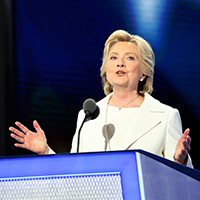
Democratic Convention: Beyond the Headlines
/ Peter DykstraView the page for this story
Peter Dykstra discusses the Democratic National Convention that nominated Hillary Clinton and Tim Kaine with host Steve Curwood, and reflects on the party's environmental platform, as well as the speakers who addressed related issues at Philadelphia last week. (05:30)
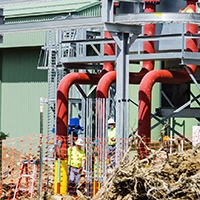
Compressor Station Controversy
/ Joanna RichardsView the page for this story
Compressor stations that pressurize gas to keep it flowing through pipelines have proliferated across the country as the natural gas industry expands. But some residents who live near these compressor stations in Ohio complain of health problems that they link to the new facilities. (06:50)
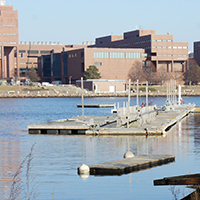
Boston in a Warmer World
View the page for this story
As a port city with low-lying areas, Living on Earth’s hometown of Boston, Massachusetts is particularly vulnerable to the sea level rise anticipated from global warming. So the City of Boston is arming itself with knowledge. The Mayor has commissioned a team of experts called Climate Ready Boston to report on future climate impacts. By the harbor’s edge at the University of Massachusetts’ Boston campus, hydrology professor Ellen Douglas and host Steve Curwood discuss the alarming implications of the report that she and an interdisciplinary group of academics put together. (09:55)

Brexit and the Environment
View the page for this story
The UK’s vote to leave the European Union raises questions about how Europe will meet its commitments under the Paris Climate Agreement, as the EU negotiated its greenhouse gas emissions cuts as a bloc. Rachel Kyte of the UN’s Sustainable Energy for All tells host Steve Curwood that the jury’s out on how Brexit and Britain’s consequent political shifts might affect other environmental policies as well. (08:50)

Woodwell - A World to Live In
View the page for this story
Ecologist George Woodwell has decades of research and environmental action under his belt, from documenting the dangers of DDT and climate change to founding the Woods Hole Research Center helping start other key organizations including the Environmental Defense Fund, the Natural Resources Defense Council and the World Resources Institute. His new book, “A World To Live In,” offers a reflection on the dangers of exceeding the planet’s biophysical limits. Speaking with Living on Earth Host Steve Curwood he shared some lessons he has learned about nature and environmental policy. (10:30)
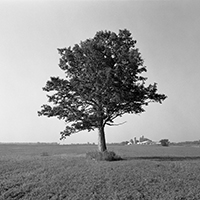
The Place Where You Live: Bear Creek, WI and St. Paul, MN
/ Regina FlanaganView the page for this story
Living on Earth gives a voice to Orion magazine’s longtime feature, The Place Where You live. This week, photographer and landscape architect Regina Flanagan celebrates the special trees that humans have chosen to keep and care for in both town and country. A single white oak in a hayfield on her family’s farm in whose shade they ate lunch inspired her childhood adventures and her photography. (05:30)
Show Credits and Funders
Show Transcript
HOST: Steve Curwood
GUESTS: Ellen Douglas, George Woodwell, Rachel Kyte, Regina Flanagan
REPORTERS: Joanna Richards, Peter Dykstra,
[THEME]
CURWOOD: From Public Radio International, this is Living on Earth.
[THEME]
CURWOOD: I'm Steve Curwood.
Planning for a wetter future in Boston thanks to global warming.
DOUGLAS: What really is troubling is towards the end of the century where we could see anywhere from 4 to 7 feet or as much 10 feet of sea-level rise, you know that’s the maximum estimate assuming all possible things go wrong at the same time, but still // that’s a lot of water.
CURWOOD: What to expect with climate change and how to adjust.
Also, residents along natural gas pipelines complain about the air near compressor stations used to keep the gas moving; there are no details about emissions, but companies say there’s no problem.
BROWN: When somebody’s child wakes up with nose bleeds in the middle of the night regularly, then they know something is going wrong. Although they’re told that the child should be alright because the air standards aren’t being violated.
CURWOOD: That and more this week, on Living on Earth. Stick around.
[NEWSBREAK MUSIC: Boards Of Canada “Zoetrope” from “In A Beautiful Place Out In The Country” (Warp Records 2000)]
[THEME]
Democratic Convention: Beyond the Headlines
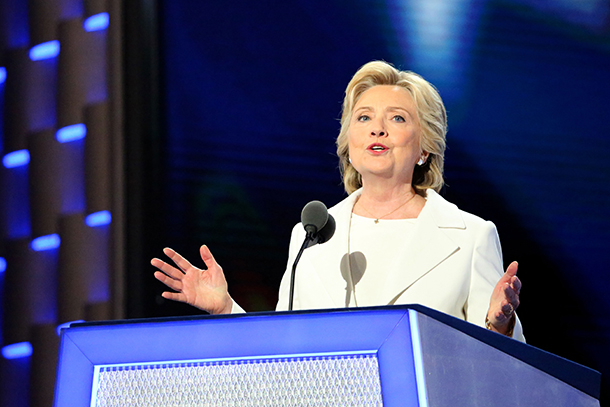
Hillary Clinton gives her acceptance speech at the 2016 Democratic National Convention in Philadelphia, PA. (Photo: Ali Shaker/VOA, Wikimedia Commons)
CURWOOD: From the Jennifer and Ted Stanley studios at the University of Massachusetts Boston and PRI, this is Living on Earth. I’m Steve Curwood. We begin this week with Peter Dykstra and some analysis of the Democratic National Convention in Phildadelphia. Peter is with Environmental Health News, that’s ehn dot org and DailyClimate dot org, and joins us from Conyers, Georgia. Hey Peter, I imagine the history books will feature the first woman to be nominated for president by a major party.
But what about the precedents set for the environment?
DYKSTRA: Hi Steve. You know, with the Democrats, nearly every speaker I watched mentioned climate change and the environment. And though there were a lot of pro-coal signs on the GOP convention floor in Cleveland, the Republican speakers barely mentioned it.
CURWOOD: So what do you make of that?
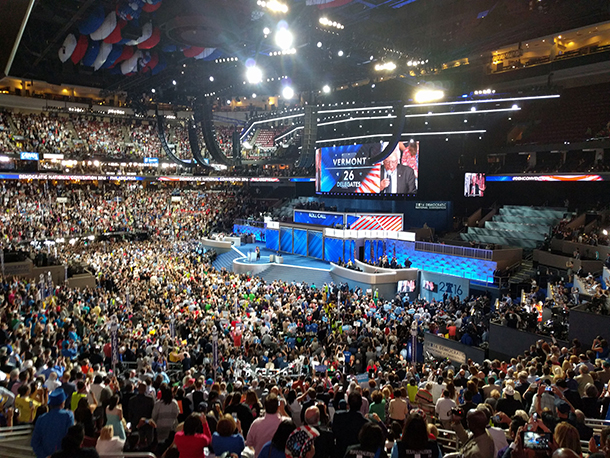
Vermont Senator Bernie Sanders spoke at the Democratic National Convention on the first day of speeches. (Photo: JefParker, Wikimedia Commons)
DYKSTRA: Well, given how polarized the two parties are on the environment, to me it suggests that the Democrats see the environment as a campaign strength from coast to coast. The Republicans may only feature climate, and energy, and the environment in places where there are major controversies -- like the fate of coal in Appalachia, public lands and endangered species in many of the western states, oil and gas in oil and gas-producing states, and water rights in California’s Central Valley. Elsewhere the GOP just might not talk about it a whole lot.
CURWOOD: So, which Democratic speech really stood out on climate change?
DYKSTRA: Probably the one from Bernie Sanders. Don’t underestimate how much impact the Sanders campaign had on environmental issues, with strong pushback on things like fracking and the Trans Pacific Partnership trade deal.
CURWOOD: Well, the trade deal is one issue that Mr. Trump and Bernie are on the same side.
DYKSTRA: They are, but not entirely for the same reasons. But when Bernie Sanders spoke on the first night he delivered powerful words about “the need to leave this world in a way that is healthy and habitable for our kids and future generations.” It was part of a speech designed to heal the rifts between Clinton and Sanders supporters. Both Hillary Clinton and Tim Kaine, her running mate, have in the past shown support for the fossil fuel industry and for trade deals like the TPP, and that’s a major factor in the anti-Hillary sentiments voiced by some convention delegates.
CURWOOD: So, a lot of folks mentioned climate and environment. Who focused on it?
DYKSTRA: The Mayor of Flint Michigan, Karen Weaver, talked about the drinking water crisis in her city. The actress Sigourney Weaver introduced and narrated a compelling short film on climate change from director James Cameron. But the only scheduled speaker with specific environmental credentials was Gene Karpinski of the League of Conservation Voters. LCV has always described itself as a non-partisan group, but the partisan divide on the environment is so strong right now that not only have they endorsed Hillary Clinton, they did so eight months ago, before it was clear that either Clinton or Trump would be the nominees of their parties.
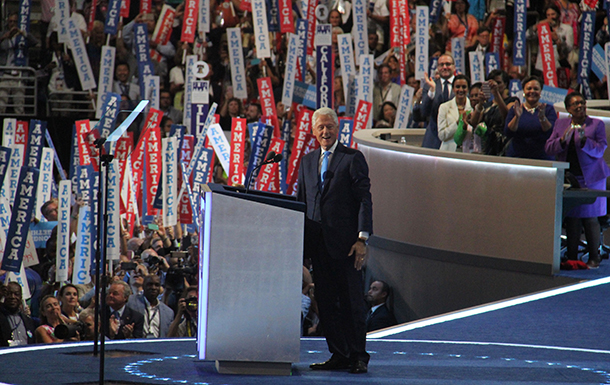
The amassed crowd at this year’s convention and former President Bill Clinton. (Photo: Disney/ABC Television, Flickr CC BY-NC-ND 2.0)
CURWOOD: What about Al Gore?
DYKSTRA: Al Gore announced that he would skip the convention, just like he did in 2012.
CURWOOD: So it looks like climate change got a bigger shout-out than at any previous convention, but the inconvenient truth is that Mr. Inconvenient Truth wasn’t there.
DYKSTRA: That’s right.
CURWOOD: Hey Peter, last week, we looked at the GOP’s environmental platform, so let’s take a run through the Democrats.
DYKSTRA: Sure. The Democratic platform calls for environmental constraints on trade deals like TPP, but it doesn’t oppose such deals outright, possibly thanks to Bernie Sanders, it backs away from the Obama Administration’s “all of the above” energy policy with goals and targets to pretty much phase out fossil fuels, get 50% of our electricity from clean energy in a decade, and cut out most greenhouse gas emissions by the year 2050. It also endorsed the call to investigate alleged corporate fraud by fossil fuel companies on climate change issues, and oppose any oil and gas drilling in the Atlantic or the Arctic.
CURWOOD: I can’t see many folks in the oil and gas industry signing on.
DYKSTRA: Right, but one bit of common ground between the Democrats and ExxonMobil -- they both want a carbon tax. Here are a few more intriguing new wrinkles from the Democratic Party: they want to decriminalize and regulate marijuana nationwide – and that might actually have a big environmental impact given the huge energy and environment footprint that illegal pot farms leave. In the wake of the tragedy in Flint, Michigan, the party uses strong language to condemn environmental racism in inner cities and on Indian lands, in farm communities and elsewhere. And the platform calls for removing all lead hazards, as part of a massive push for 21st century infrastructure involving energy efficiency, transportation, water systems, the electric grid and more.
CURWOOD: So obviously, the differences in the two party platforms are as huge as the differences in the candidates. Hey, what else did you pick up from the platform?
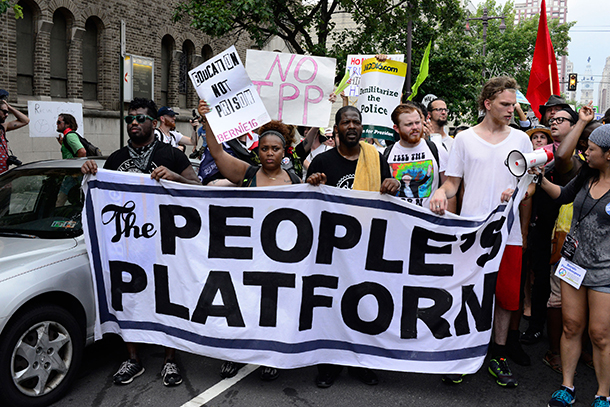
Thousands of Bernie Sanders supporters assembled outside the convention center to protest Democratic platform policy and in particular voice their objections to the Trans-Pacific Partnership. (Photo: Stephen Melkisethian, Flickr CC BY-NC-ND 2.0)
DYKSTRA: The thing that makes the Democratic platform remarkable is that the issues we cover on this show – energy, environment, climate change — aren’t just roped off into a block of a few pages, they’re present throughout the entire document. Environment is a component in goals on – and I’m going to give you a long list from the platform-- infrastructure, clean energy jobs, science and tech education, NASA, fixing the financial system and fixing the campaign finance system and corporate concentration, fair trade, racial gaps in income and opportunity, immigration, agriculture, Native Americans, public health, keeping a lid on nuclear, chemical and biological weapons, and illegal wildlife trafficking.
CURWOOD: Well, that’s a lot of talk, but is it just talk?
DYKSTRA: Well, whether it’s the Republicans’ platform or the Democrats’, it’s a wish list, just like the President’s State of the Union Address every year, or for that matter, when a contestant in one of Donald Trump’s beauty pageants tells us she wants to achieve world peace and end hunger. Either way – and whoever wins – it’s ultimately up to us to hold the parties accountable for what they promise us in their platforms and in their convention speeches.
CURWOOD: Peter Dykstra is with Environmental Health News, that’s ehn.org, and dailyclimate.org. Thanks so much Peter.
DYKSTRA: All right Steve. Thanks a lot.
CURWOOD: And there’s more on these stories on our website, loe.org.
Related links:
- Hillary Rodham Clinton convention speech video
- Bernie Sanders convention speech video
- Democratic Platform 2016
- The Democratic Party’s primary election October 2015 climate change debate
- Gene Karpinski President of the League of Conservation Voters spoke about climate change in detail at the DNC
Compressor Station Controversy
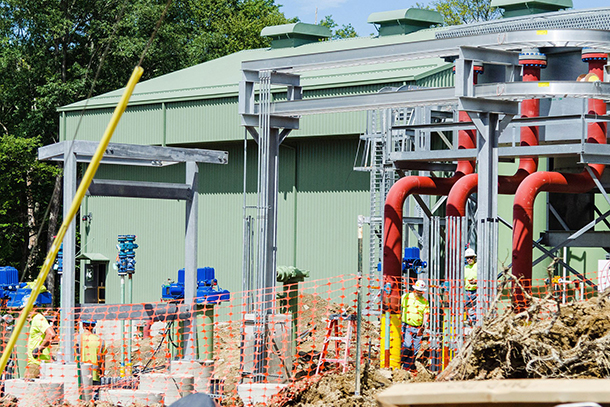
Compressor stations, like this one near Milford, Pennsylvania, are critical—if not well-known—components of the nation’s energy infrastructure. They are needed every 40 to 100 miles along pipelines to re-pressurize natural gas and keep it moving over long distances. But the possible health impacts of these facilities are just now being studied by researchers. (Photo: Anne Meador / Cool Revolution via Flickr)
CURWOOD: Another flashpoint has emerged in the fracking controversies – compressor stations.
Hundreds of miles of new pipelines are in the works to transport shale gas to market.
And to move that gas, compressor units must also be built. From the Marcellus shale region, the Allegheny Front’s Joanna Richards has our report.
RICHARDS: 300 people crowded into a school gym in Medina County, Ohio, in February, to lob questions, concerns and some unvarnished anger at state environmental regulators.
MAN AT MEETING: Building this compressor station so close to people’s homes speaks of greed over safety.
SECOND MAN: The Ohio EPA is not here on our side (APPLAUSE). We have to stand up! (LOUDER APPLAUSE)
RICHARDS: The Ohio Environmental Protection Agency held this meeting as part of the permitting process for siting a compressor station along the planned NEXUS pipeline. There are about 150 compressor stations in Ohio already, and state officials say there are about 15 new ones planned.
Compressor stations are needed every 40 to 100 miles along pipelines, to re-pressurize the gas and keep it moving. Like other industrial facilities, they are allowed to emit limited amounts of air pollutants. Ohio EPA and energy companies say the facilities are safe and well regulated. But some people who live near them say the pollution is making them sick.
[SOUND OF JANGLING COLLARS, DOG BARK]
BARRY BOOTH: The dogs stick their nose to the door, turn around and come right back in the house.
RICHARDS: Barry Booth says his dogs gave him an early sign something was wrong with the air at his Carroll County home, in eastern Ohio. In 2013, pipelines, wells and compressor stations had sprouted up all around him. Booth, who’s retired from manufacturing, didn’t have a problem with this. He’d even signed a lease agreement with Chesapeake Energy to make some extra money. Then one day he went to get his wife, Mary Booth, a cup of coffee. He landed on the floor, nauseated and dizzy.
MARY BOOTH: I jumped up to check on him, and then ended up beside him. It was just really hard to breathe, and the odor was very strong.

Carroll County resident Barry Booth stands near his home, which is within sight of a natural gas compressor station. He believes emissions from the facility have contributed to his family's health problems, including nausea, rashes, nosebleeds, headaches and his wife's breast cancer. (Photo: Joanna Richards)
RICHARDS: The Booths say they started having rashes, nosebleeds and headaches.
The couple blames air emissions from the nearby gas facilities, especially a big compressor station. That facility’s permit allows it to emit limited amounts of carbon monoxide, volatile organic compounds, and particulates, among other pollutants.
There hasn’t been a lot of research on the health impacts from oil and gas development, especially focused on just compressor stations. So how worried should people be? That’s what Trevor Penning is trying to figure out. He leads the Center for Excellence in Environmental Toxicology at the University of Pennsylvania.
Penning and some colleagues compared health trends in neighboring counties with and without heavy gas development.They analyzed all inpatient hospitalization records between 2007 and 2011 - 92,000 records in all. Wayne County, without fracking, followed the national trend of declining hospital admissions. But in Susquehanna and Bradford counties, where gas extraction had taken off...
PENNING: There was an increase in inpatient hospitalization rates, which comes out to be about 3 percent per year.
RICHARDS: Penning says that’s significant, and many of the health issues were things you’d expect from air pollution, like heart problems. His study didn’t measure pollution levels, or possible sources.
PENNING: I actually feel that many residents who feel their health has been affected by this activity need to be listened to.
RICHARDS: As more pipelines are built, more people outside drilling regions now find themselves near compressor stations, too. That’s why David Brown says it makes sense to try to single out these facilities for research. He’s a public health toxicologist with the Southwest Pennsylvania Environmental Health Project, a research and advocacy group. It’s funded in part by the Park Foundation, which also supports this reporting project.
Brown heard complaints from people in the town of Minisink, New York. There was a compressor station there, but no other gas activity. He says the closest regional air sampling station - part of a federal monitoring network - showed pollution levels in compliance with federal standards. But when he did air monitoring in people’s homes near the compressor station, particulate matter tested higher than the regional numbers. He also had residents keep health diaries, and Brown says there were problems.
BROWN: When somebody’s child wakes up with nose bleeds in the middle of the night regularly, then they know something is going wrong. Although they’re told that the child should be all right because the air standards aren’t being violated.
RICHARDS: Brown says the federal standards aim to improve overall regional air quality, but they’re not designed to protect people from frequent, close-range pollution exposure. Brown’s research project was small, but he says his findings and others’ suggest compressor stations alone can be powerful polluters. Federal studies near two compressor stations in Pennsylvania found fine particulate matter and other pollutants at levels that could be harmful to people’s health - although those studies, too, say their findings are limited.
In Pennsylvania, regulators agree more data is needed. The state plans to install more air monitors in areas with compressor stations and gas wells next year. Some health advocates want more oversight of individual facilities too. Right now, regulators rely mostly on companies’ own emissions data. Mike Hopkins is with Ohio EPA’s division of air pollution control.
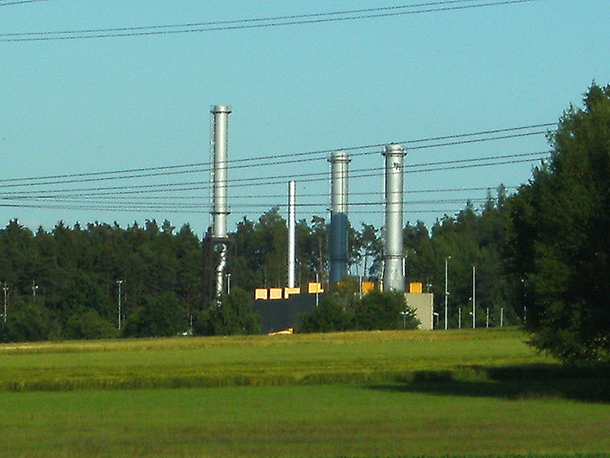
The Weiherhammer compressor station in Germany (Photo: Zonk43, Wikimedia Commons)
HOPKINS: It would be nice to be able to have an employee out at every single facility on a 24-hour basis to verify compliance, but the reality is that we can’t afford to have that level of staffing.
RICHARDS: And an industry spokesman says, when it comes to compressor stations, activists are making a mountain out of molehill. Jimmy Stewart is president of the Ohio Gas Association, a trade group.
STEWART: Yes, there are some emissions from operating a compressor station. They pale in comparison to the emissions of a whole lot of other things that you are exposed to on a daily or weekly basis.
RICHARDS: Stewart says people have less to fear from compressor stations than they do from traffic exhaust and gas station fumes. But Barry Booth - the man who lives near a compressor station in Carroll County - says he and his wife are so afraid for their health, after decades in this region, they’re planning to move. A neighboring family settled a lawsuit with a company over a different compressor station. Now Booth, a former local union leader, is back to battling companies in retirement. At public meetings, he’s urged people to fight new compressor stations.
BARRY BOOTH: That’s what pisses me off. I would not be doing any of this if the company would be doing what they’re supposed to be doing to the environment and everything, I would be out smelling the roses! I would be getting my paycheck from the gas and oil industry and everything!
RICHARDS: The country wants the homegrown energy and jobs from oil and gas development. But Trevor Penning, the U. Penn public health researcher, says it comes with a cost.
PENNING: The EPA always works on not the concept of no risk, but acceptable risk…so the issue becomes is, what is the acceptable risk here?
RICHARDS: Penning says there’s a huge need for more information about compressor stations, to clarify what the risks actually are. I’m Joanna Richards.
CURWOOD: Joanna reports for the Pennsylvania public radio program, the Allegheny Front.
Related links:
- See the story on the website of the Allegheny Front
- The proposed NEXUS Gas Transmission system
- Project overview and map of the NEXUS Gas Transmission system
- Summary of Minisink compressor station monitoring results
- PLOS Journal Article: “Unconventional Gas and Oil Drilling Is Associated with Increased Hospital Utilization Rates”
- The Environmental Health Project
[MUSIC: Diunna Greenleaf & Blue Mercy, “A Change Is Gonna Come,” Cotton Field to Coffee House, Sam Cooke, Diunna Greenleaf (self-released)]
CURWOOD: Just ahead – how the British vote to leave the EU complicates climate deals. That’s just ahead on Living on Earth – stay tuned.
ANNOUNCER: Support for Living on Earth comes from the Gordon and Betty Moore Foundation, and from a friend of Sailors for the Sea, working with boaters to restore ocean health.
[CUTAWAY MUSIC: Yo-Yo Ma, Edgar Meyer, Mark O’Connor, “First Impressions,” Appalachia Waltz, Edgar Meyer, Sony Music Entertainment]
Boston in a Warmer World
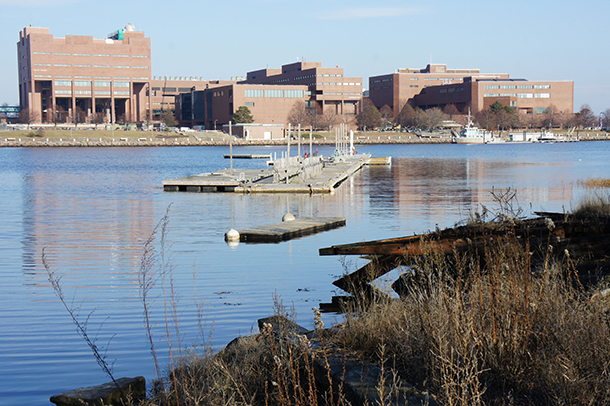
UMass Boston’s campus, the home of Living on Earth, is about twenty feet above the high-tide level. (Photo: UMass Boston Photos)
CURWOOD: It’s Living on Earth. I’m Steve Curwood, and we’re in our frontyard, or maybe our backyard, because here at the University of Massachusetts, where we are in Boston, we are on Boston Harbor. And joining us right now is UMass Boston Professor Ellen Douglas. She's a hydrologist who's been studying what would happen to the city of Boston as climate change advances. Welcome to Living on Earth.
DOUGLAS: Thanks. Happy to be here.
CURWOOD: First, tell me, what inspired local leaders to form the team that’s called Climate Ready Boston?
DOUGLAS: Well, it’s been a long time in coming. The city has been working on climate change adaptation and mitigation for a while, but in 2012, when Sandy really devastated New York City, it made a lot of people in Boston realize that we dodged the bullet and that we need to make sure that we're prepared for the event, if something like that happened here.
CURWOOD: So, you have a good size team, what, 20 of you who’re working on this project at various institutions. Talk to me about the disciplines that they bring to the table.
DOUGLAS: Yeah, we had quite a variety. It was really, really quite exciting and very educational too, to work with all these people. We had oceanographers, we had climatologists, we had meteorologists. we had hydrologists, we had engineers, oh, atmospheric scientists, climate scientists, economists. We had people working in consulting firms. We had people from Harvard and Northeastern and Boston University, all the local universities. The list is almost endless. (LAUGHS.)
CURWOOD: Because I guess this touches every part of society.
DOUGLAS: It does. It does. It’s not even just the physical sciences. It’s the social sciences and the economics, as well.
CURWOOD: So here we are, on the edge of the Harbor in Boston. Now, I'm told that the campus itself is almost 20 feet above sea level, the main buildings, but of course we're down on the walkway by the boats, where, oooh, when the tide is up, it’s got to be just six feet away from us. Okay, Ellen, you can tell us. (SHE LAUGHS.) What would happen if Sandy had come here to Boston? What would it be like for us out here at this campus, this harbor?
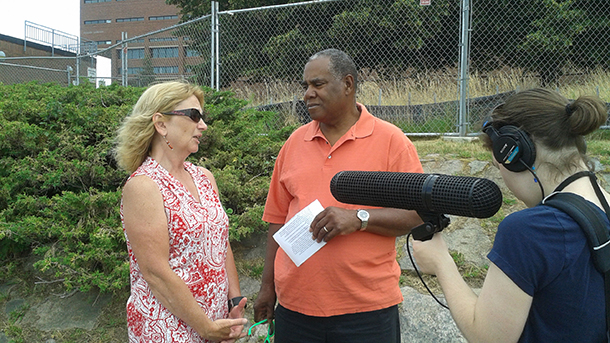
Hydrologist Ellen Douglas gives Living on Earth host Steve Curwood the bad news about the anticipated climate impacts that lie ahead for the city of Boston, as Jenni Doering records. (Photo: Helen Palmer)
DOUGLAS: Well, while we were standing on the harbor walk, we probably would've gotten feet wet. Campus itself, as it exists right now, amazingly is above even the highest of the scenarios that we looked at, as far as water levels; however you wouldn’t be able get on or off campus because all of Harbor Point area and Morrissey Boulevard entrance would be completely submerged, so it would be kind of like an island at that point.
CURWOOD: So let's get out of our backyard. Talk to me about the bad news here. How much sea level rise is projected in Boston in the coming decades? What are we looking at for the city as a whole?
DOUGLAS: Well, at about mid-century we could be looking at anywhere from, you know, six inches, eight inches up to a foot or so. What really is troubling is towards the end of the century, where we could see anywhere from four to seven feet or as much as ten feet sea level rise. You know, that's the maximum estimate, assuming all possible things go wrong the same time, but still, you know, that's, that's a lot of water.
CURWOOD: So people who’re curious about what that would do the Boston and want to see this visually can go to our website loe.org and see the wonderful map that you guys put together,or I should say maybe it’s a terrifying map. But for folks who are listening, just describe what happens to Boston, say, with 10 feet of sea level rise.
DOUGLAS: 10 feet of sea level rise, you end up with South Boston flooded, the financial District flooded, and the Charles River dam can be over-topped or short-circuited so that water gets back behind it into Back Bay and Cambridge, so a very large part of the city that's not used to getting wet would be wet.
CURWOOD: And I imagine, as a hydrologist you’ve looked at other places that have dealt with this. I’m thinking, of course, of Holland, I’m thinking of the part of the Netherlands that's underwater already and other places in the world.
DOUGLAS: Yeah, well, actually as part of the Climate Ready Boston, interestingly enough, they sent a contingent of people from Boston to the Netherlands, to Denmark, to those communities who have been dealing with this kind of issue for centuries to get some ideas and some suggestions and advice.
CURWOOD: Now, there’s more to climate change than just rising sea level, of course. We're recording this just a summer is really starting to heat up, and in your report you say the summers are already getting hotter here in Boston, so how much hotter is hotter, and what kind of heat is ahead?
DOUGLAS: The average temperatures, I think, are going to go up eight to ten degrees. What really is troubling is the number of days above 90 degrees and above a hundred degrees that we're just not used to hear in the northeast. Typically days above 90 degrees, we get about 11 a year, and by the end of the century, under the highest emission scenario, that could be as many as almost 90 days a year which is like a full summer’s worth of heat wave.

Light blue areas on this map show the parts of Boston that could be innudated under five feet of sea level rise. (Photo: produced using NOAA’s Sea Level Rise tool at https://coast.noaa.gov/slr/)
CURWOOD: Over how many degrees?
DOUGLAS: 90 degrees.
CURWOOD: Oh, my.
DOUGLAS: Yah, heat extremes are a big concern as well as sea level rise.
CURWOOD: I was going to say, people die when it gets that hot. In Chicago, for example, in a heat wave not so long ago, people died.
DOUGLAS: Yah, and it's not even just the number of days, but it's the number of consecutive days, so after about three to five days, you know, cooling systems actually they just can't keep extracting the heat, and so a lot of air conditioning systems begin to not work as well and as efficiently, and it's a real concert health-wise when you're looking at that kind of temperature.
CURWOOD: Water, heat, this is not a positive scenario.
DOUGLAS: No, sad to say, it’s not.
CURWOOD: So, what about other eastern seaboard cities? How much trouble do they face from climate disruption compared to Boston, do you think?
DOUGLAS: Well, pretty much everybody along the coast, they're facing similar issues. Here in Boston in some ways we have an advantage because we have a very high tide range. So it’s a 10 foot tight range, so a lot of our infrastructure is built for this big range. In New York City their tide is only like four feet, two feet up and two feet down, and so that's why when you got a big storm surge on top of their minimal tide range, it really caused a lot of devastation. Here, if a five foot storm surge hits in Boston, which is our extreme storm at low tide, we might not even notice. And that all depends on where you are on the coastline.
CURWOOD: So we’d better not have a full moon and high tide when the next big storm surge comes.
DOUGLAS: (LAUGHS.) Yeah, that's exactly what happened in New York City. The highest high tide and a record storm surge hit at exactly the same time.
CURWOOD: Tell me, why is it important to engage with the Office of the Mayor here on the issue of climate change in Boston?
DOUGLAS: Well, they’re the movers and shakers, right? He’s the one that makes the proclamation that says, “This is a priority for Boston,” and tries to bring people in line, and when you’ve got them on your side it’s a lot easier to get things done.
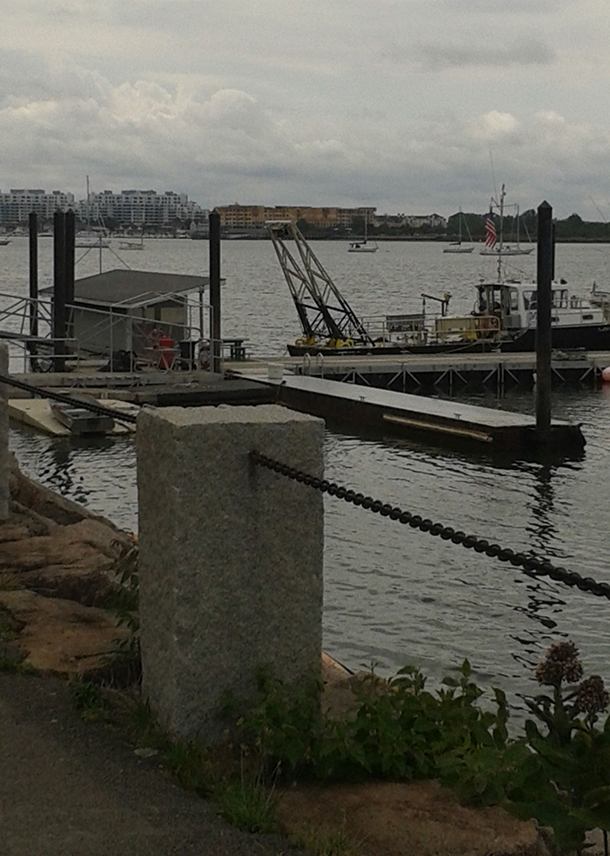
Savin Hill Cove borders the UMass Boston campus (Photo: Helen Palmer)
CURWOOD: So Boston is about 400 years old. In another 400 years, is there a Boston as we know it?
DOUGLAS: Well, not as we know it, for sure. It’s hard to say, I mean, even in another 200 years there could be parts of Boston that are under water, and so you have to deal with that either by putting up some sort of protective barriers or building buildings higher or whatever, but it's definitely not look like it does today.
CURWOOD: Your task force is moving ahead to prepare a vulnerability assessment and look at some resilience strategies. How do you put that together?
DOUGLAS: Well, the teams that are working on that right now have done a lot a lot of data mining, looking at reports and data that are already existing, to pull it together, integrating it into the strategy that the city wants to take. A big part of it is outreach to communities, to figure out what they're most worried about, and bring in not just city itself but the agencies like Massport, MBTA, Mass DOT, and all the agencies are, are figuring out how their infrastructure is going to be impacted, how their operations are going to be impacted, and it's a matter of figuring out how you're going to work that into the long-term plan. We have time, which is the good news. We have some vulnerability now, but the agencies have time to integrate this into their long-term planning as far as upgrading their infrastructure or building new infrastructure for protection and for flood-proofing, things like that.
CURWOOD: In the immediate future what do you think’s the biggest risk of a climate event here?
DOUGLAS: Probably a big coastal storm. I mean, we're right here on the coast, and not so much a hurricane -- we don't get hurricanes as often as you think -- but a big nor'easter like we saw in ’91, you know, the no-name storm or the perfect storm? That actually caused the largest storm suge we’ve seen, so that's probably the most likely in combination with a lot of precipitation.
CURWOOD: So this is not so much the future but really now.
DOUGLAS: Yuh, yuh, I think we're seeing that pretty much everywhere in the country and the world.

Ellen and Steve spoke on the UMass Boston Harborwalk by Savin Hill Cove (Photo: Helen Palmer)
CURWOOD: How many folks understand that this is an emergency and that people need to move, not just fast, but really fast?
DOUGLAS: Yeah, that is a challenge. We’ve thought of climate change as this long term impact, but observations over the last decade have showed us that, yes there’s long-term impacts, but there's also impacts that are occurring now and things are happening faster than we expected so that is a challenge. And I guess nature sort of helps us out in that way, if you can think of it that way, by, you know, all the flooding and the Superstorm Sandys and things like that definitely get people’s attention.
CURWOOD: For example, right now as we're talking here in Boston, there are wildfires in, I don't know how many states, so it's pretty intense right now.
DOUGLAS: Well and the thing that’s striking is the number of times you hear “record-breaking,” and, you know, statistically speaking, records will always be broken, but the time between records is supposed to increase, but records are being broken over and over and increasingly faster, and so that's what makes realize that the climate is changing, too, is because everything that happens seems to be a record event.
CURWOOD: Professor Ellen Douglas teaches hydrology at the University of Massachusetts Boston. Ellen, thanks so much for taking the time today.
DOUGLAS: Oh, this is fun. Thank you.
Related links:
- Climate Ready Boston
- Read the Climate Projections Consensus on anticipated climate impacts in Boston
[MUSIC: Odetta and Dr. John, “Brother, Can You Spare a Dime?” Brother Can You Spare a Dime-Day, Yip Harburg/Jay Gorney, The Harburg Foundation]
Brexit and the Environment

The United Kingdom voted to leave the European Union after over four decades of membership (Photo: freestocks.org, Flickr Public Domain)
CURWOOD: The recent vote in Great Britain to leave the European Union, known as Brexit, has roiled global financial markets, pushed the British pound to a 30 year low against the dollar, and raised questions about how the UK and EU will now deal with the environment.
There are concerns that Brexit could slow ratification of the Paris Climate Agreement, though that accord can go into force if 50 countries and those representing 50 percent of global emissions ratifiy it, and the EU including the UK only represents 10 percent of emissions. But the EU has been a leader in climate and environment, so for some insight, we turn to Rachel Kyte, the CEO of the UN’s Sustainable Energy for All initiative. She joins us from Washington, D.C. Rachel, welcome back to Living on Earth.
KYTE: Hi, thank you for having me back.
CURWOOD: You're speaking to us from your office in D.C., but I understand that you yourself are a Brit. Can you briefly describe how much of the UK's carbon and energy targets currently ride on the policies of the EU?
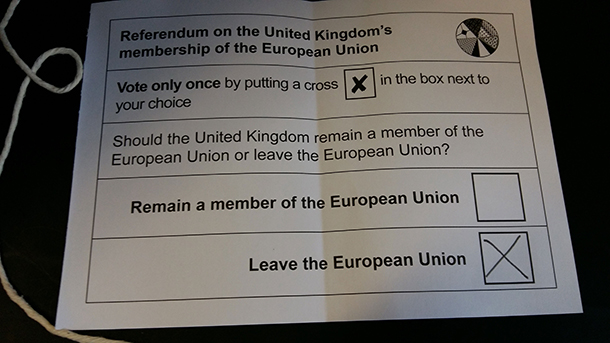
The “Leave” campaign won 51.9% of the British vote. (Photo: (Mick Baker)rooster, Flickr CC BY-ND 2.0)
KYTE: Yes, I've got one of those Queen Mary accents, stuck somewhere between the UK and US. [CURWOOD CHUCKLES] So I think, to step back, the climate targets have been negotiated by the international community were negotiated by the European Union as a bloc with United Kingdom party that's agreement. And so the targets for emissions reduction, a 40% of economy wide reduction over 1990 emissions levels, were negotiated with UK’s economy included.
Increasingly around the world, in order to achieve a low carbon economy, you know the focus really is on regional energy integration. And so, you know, Britain's energy future lies within a European energy market. I mean, our ability to import clean wind power from Denmark etc. at a reasonable price, this is part of the future that we were building, so I think there’s question marks over what the commitment of the country and the new government is for that kind of future.
CURWOOD: So this raises a bunch of questions. First of all the UK is taking its time to leave the union, as, I guess, it’s a two-year process, and actually that fuse hasn't even been officially lit, as I understand it, so is the whole commitment business just going to wait for the next two years while Britain sorts things out?
KYTE: Up until Bexit the assumption was that European Union would ratify quickly. Now, for the EU to ratify, every country within the European Union has to ratify itself, so today France and Hungary have already done that. Now the UK really would appear to have two options. One that it can ratify now as an EU member state, which would enable EU-wide ratification to go ahead. The second option would be that the UK not ratify now, in which case the EU wouldn't be able to do so, for as long as the Brexit negotiations persist. And that risks a potential delay in the Paris agreements entry into force. The European Union is continuing on, as if nothing has changed because, indeed, Article 50 has not been invoked yet, but I think the consternation within the community is the uncertainty of not knowing when and how the United Kingdom will exit the European Union and exactly under what terms and what decisions the European Union and the UK will reach, in terms of going it alone or continuing to operate within the EU's targets.
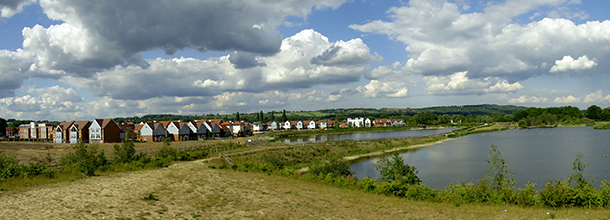
Britain has been a key leader in the European Union on environmental policy. Above, a nature reserve borders a housing development to provide habitat for waterfowl. (Photo: Gareth Williams, Flickr CC BY 2.0)
CURWOOD: And of course the UK has sharply reduced its emissions over the years, thanks to closing down the coal mines and much use of coal there. So what happens now if the EU has to go it without the sharp reductions that the UK has made?
KYTE: So first point, I think, is to acknowledge that the emissions need to be reduced now across the energy sector. There needs to be a continued drive of energy productivity across the European Union including UK. There needs to be a real driving down of emissions from the transport sector across the European Union. And then, of course, you know, a very sensitive issue is the emissions that come from land use and land use management, including farming. It's very clear that if the United Kingdom is taken out of the way in which burdens have been shared across the European Union, then you have two choices. One is that you come up with a weaker goal or that you have to go back and ask other European union countries to make the deeper cuts.
CURWOOD: Sounds complicated and difficult.
KYTE: You know, at best this is a distraction. At worst this is disruptive because at this point in time, you know, absent Brexit, we would be really looking at ramping up action across the economy to make the European economy as productive and competitive as possible, and we would be really looking for perhaps even greater ambition because remember in Paris we agreed to be way below two degrees. And INDC's that were filed in Paris, when you added them up, got just about three degrees, so we have more to do anyway.

The UK may need to renegotiate its emissions reductions responsibilities in the Paris Agreement. (Photo: shirokazan, Flickr CC BY 2.0)
CURWOOD: So, overall, how do you think that the Brexit event is going to influence environmental policy in the UK and the EU going forward?
KYTE: So, we've been talking about emissions and sort of the climate angle on this. I think that domestically there’s a huge adaptation issue in Britain. Britain is, you know, a sort of rocky outcrop of the coast of Europe and extremely vulnerable to climate change, and the amount of investment in domestic infrastructure to withstand the volatility of the weather and the intensification of extreme weather is something which is been very much in the forefront of the environment agency and is very much in the minds of communities around the UK. So how will the funding for all of that become mobilized within domestic economy? And then finally farming and fishing and the way in which we sustainably manage those processes will now be the subject of extremely complicated negotiations as one assumes that Britain will exit from the common agriculture policy and the common fisheries policy.
CURWOOD: Well what do you think of the argument that Brexit could actually benefit the environment because the UK may still be bound by EU laws but would no longer have any say and be able to weaken them?
KYTE: Well, I mean, my view is that the UK has been a powerful force for good within the European union, since it's negotiated its entry and since it's been a member of the European Union. And when it comes to energy and climate and sustainable development, the UK has been, you know, a steady voice for action because we've had a cross-party commitment to a greening the economy and to climate action over the past decade or more. It's been a constant leadership voice within the European Union, so, I think, to lose that voice, I think, is to the detriment of the European Union. And then from a domestic point of view we have benefited from strong European regulations to improve environmental standards. All of the early work on making public housing more energy efficient, that all came from Brussels regulations, and I think that before the referendum it was very difficult to find anybody within the field of environment or energy or climate that believed that Brexit would be a net positive.
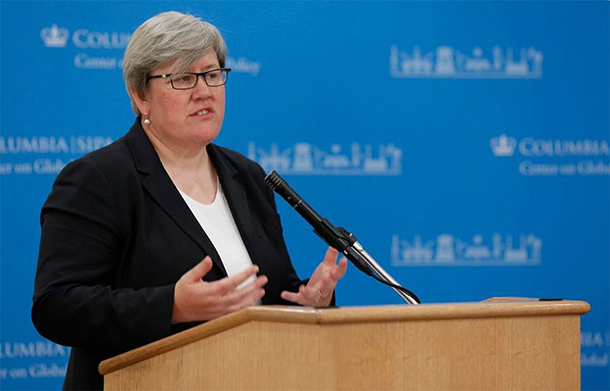
Rachel Kyte is the CEO of Sustainable Energy for All and Special Representative of the UN Secretary-General for Sustainable Energy for All. (Photo: Sustainable Energy for All)
CURWOOD: So, with Brexit the conservative Prime Minister, Mr. Cameron, resigned and now Theresa May is the new prime minister, and she immediately disbanded the Department of Energy and Climate Change. How significant is this, and to what extent do you think it may change the way that the UK mitigates and adapts to climate disruption?
KYTE: So, the dissolution of the Department of Energy and Climate Change and the creation of a new Ministry of Business, Energy and Industrial Strategies has been one of the most controversial aspects of Theresa May’s new government and new cabinet. The critics have said, you know, to take climate change out of the title of the ministry, this will result in a weakening of focus on the way climate has to be a focus of energy policy, etc. On the flipside, you know, I think there is a case to be made that the next chapter of action, as it were, really is domestic in the United Kingdom, and it's about driving climate goals through the energy system, through the transport system, through infrastructure, through housing, through the whole of business. And it’s a sort of total economy/total government approach, and perhaps on paper this new ministry potentially this would give climate change a true hold on industry, energy and business strategy. I think I'm cautiously optimistic, but if the government's truly serious about maintaining Britain's leadership in climate action, then this is going to be a ministry which really has to be given the resources to be a powerhouse.
CURWOOD: Rachel Kyte is the CEO of Sustainable Energy For All, an initiative of the United Nations. Thank you so much for taking the time today.
KYTE: Thank you.
Related links:
- Check up on the Paris Agreement’s status of ratification
- The Guardian’s Environment blog: “UK’s out vote is a ‘red alert’ for the environment”
- The Guardian: “Abolition of Decc ‘major setback for UK’s climate change efforts’”
- New Scientist: “Green lining? Five ways Brexit could be good for the environment”
- Sustainable Energy for All
- About Rachel Kyte
[MUSIC: Nick Funicelli, “All By Myself,” Youtube recording, Irving Berlin]
CURWOOD: Coming up -- words from a modern American pioneer of environmental science and policy. That's just ahead on Living on Earth. Stay tuned.
ANNOUNCER: Funding for Living on Earth comes from you our listeners, and United Technologies - combining passion for science with engineering to create solutions designed for sustainability in the aerospace, food refrigeration and building industries. UTC companies such as Otis, Carrier, Pratt & Whitney and UTC Aerospace Systems are helping to move the world forward. This is PRI, Public Radio International.
[CUTAWAY MUSIC: Thomas Clausen Band, “Prelude To a Kiss,” Stunt Records Compilation Vol.24, Duke Ellington, Stunt Records/Sundance Music]
Woodwell - A World to Live In
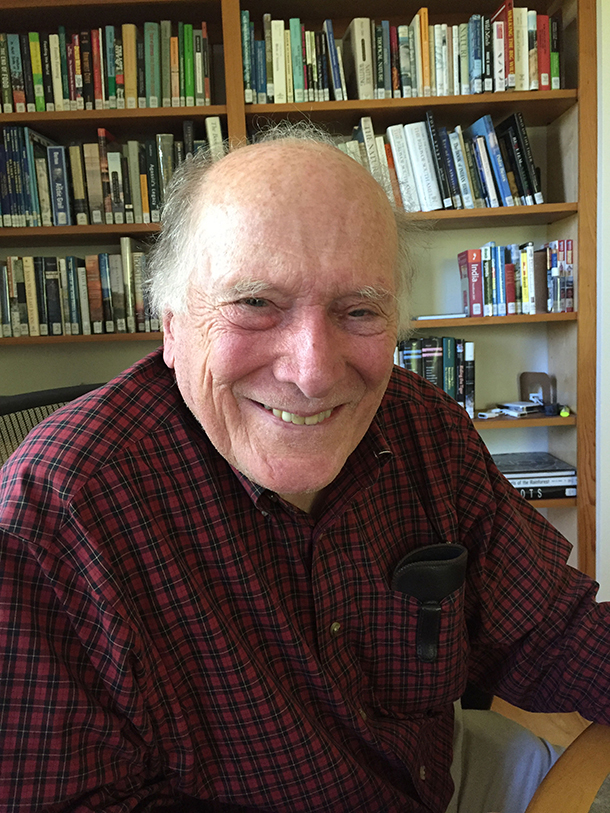
George M. Woodwell is the founder and president emeritus of the Woods Hole Research Center. (Photo: Steve Curwood)
CURWOOD: It’s Living on Earth. I’m Steve Curwood. Few scientists have as stellar record in environmental science or policy as George M. Woodwell. When he won the $200,000 Volvo Environmental prize in 2001, the citation mentioned that in the1960’s Dr. Woodwell was among the first to investigate the health effects of radioactivity, followed by groundbreaking research that ultimately led to America's ban on DDT. This unassuming biologist was part of a team who documented climate change for President Jimmy Carter in the 1970’s.

A World to Live In makes a case for how the health of the biosphere is closely linked with humanity’s future. (Photo: MIT Press)
Dr. Woodwell helped found the Environmental Defense Fund, the Natural Resources Defense Council, and the World Resources Institute. He’s also the Founder, President, and Director Emeritus of the Woods Hole Research Center, which documents how forests affect global climate and delivered seminal work that led to the UN Framework Convention on Climate Change. George Woodwell’s latest book is called “A World To Live In”. When I visited him in Woods Hole, Massachusetts, he told me that’s an increasing challenge.
WOODWELL: Well, the world is literally falling apart. We have reached a point where the opportunities for experimentation with politics and with economics, the two big systems that we admire and use and have developed to a high degree are limited -- they are limited by the biophysical limits of the earth and that topic -- the biophysics of the earth is a topic that I have pursued for my whole career and it’s perfectly conspicuous where those limits are becoming important.
CURWOOD: Reflecting on his career, George Woodwell told me about some of his earliest research into the pesticide DDT.
WOODWELL: DDT is a persistent pesticide. It was hailed as the ultimate pesticide in the postwar years when it was first released for general use. We showed in Long Island that the food web there was contaminated from the water of the marshes right on through the life of the marshes, clams, birds, and every trophic level existing at that time in the middle 1960s, had a burden of DDT residues coming from the aerial spraying of salt marshes to control the salt marsh mosquitoes within a factor of 10 of the acute lethal level for that organism. That sounds as though it's safe enough but the concentration up that food web was enormous. The concentration factors ran up to a hundred thousand fold. As a result of that we did get a court order which in the end resulted in the abandonment of DDT for use in spraying the salt marshes, and ultimately it led to the development of Environmental Defense Fund and the abandonment of DDT for general use in United States which was a wise thing.
CURWOOD: Your book paints corporations and industry interests as bearing the brunt of blame for environmental havoc through the decades. What kinds of events have shaped this perspective?

The natural landscape of Woods Hole, Massachusetts, a neighborhood in the town of Falmouth where Woodwell founded the Woods Hole Research Center in 1985. (Photo: Bill Llott, Flickr CC BY-NC-ND 2.0)
WOODWELL: Well, industries feel as though, in fact say commonly, that their purpose is financial profit at whatever cost. and they've made the assumption that cost can legitimately be pushed into the public realm. I look at this these days in a world of 7 billion people, pushing all the biophysical limits of the earth, and say, “Well, let's look at industries and ask just what their purpose is.” There is no industry that doesn't claim that it's doing something that's useful to the public in general, that they are selling a useful good of some sort, and in the process they're making a profit, but the profits get put first. Fiduciary responsibilities get talked about as being preeminent. Well, that’s ridiculous. It's absolutely not possible to have a tight world of seven billion or more people who are growing into demands, further demands, on resources all the time by developing technologies that make it possible to exploit bigger pieces of the resources available, all of those competing with one another, and turn these industries loose to do that.
CURWOOD: So, you discuss in your book what the various presidencies throughout the years have meant for the climate. So which presidents have been the best in your view? Which have been the worst when it comes to climate change policy?
WOODWELL: Oh, my. (CHUCKLES) Well, Clinton had the greatest opportunities. Actually, Carter was the very best. He understood the problem. He did things about it. He put solar panels on the roof of White House, and he developed the Solar Energy Research Institute, and he was very astute and intellectually engaged. And if he had continued, if he had not been displaced by a conservative president, Mr. Reagan, who abhored anything to do with science and with the climatic disruption, we would have been 30 years ahead of where we are now.
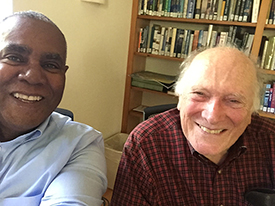
Host/Executive Producer Steve Curwood and ecologist George Woodwell at the Woods Hole Research Center in Massachusetts. (Photo: Steve Curwood)
CURWOOD: And in your view the worst president in terms of climate? Perhaps you’re suggesting President Reagan, then.
WOODWELL: (CHUCKLES.) Well, the transition that Reagan made, of course, was important, but the presidents who followed him had to go out of their way to do anything really constructive. And, when Al Gore was asked to take a vigorous stand on the climate issue while he was in office, he said, “Hmmm, you want me to commit political suicide?” Things had degenerated to that point.
CURWOOD: So, let's talk about today. What do you think a Trump presidency would mean for the climate?
WOODWELL: That's a fairly simple question. I don't think Mr. Trump has the slightest idea as to how environment limits economic and political aspirations or human aspirations, and I just don't really care to speculate as to just how bad he would be.
CURWOOD: And, in your view, what would happen if Hillary Clinton makes it to the White House?
WOODWELL: Hillary is very well-informed on virtually every topic. My guess is that Hilary will rise to the challenge. She'll be under enormous pressure from elements of the scientific community that are well-seated in the conservation law groups. The scientific community should be up in arms against the present attitude, that we can double the warming of the earth that we've experienced so far and do it safely by going to two degrees change instead of one degree change in the mean temperature of the earth as a whole.
CURWOOD: On page 100 of your book, George, you say that no threat has been great enough for the nations of the world to come together on climate change. How does the Paris climate agreement measure up to that challenge, in your opinion?
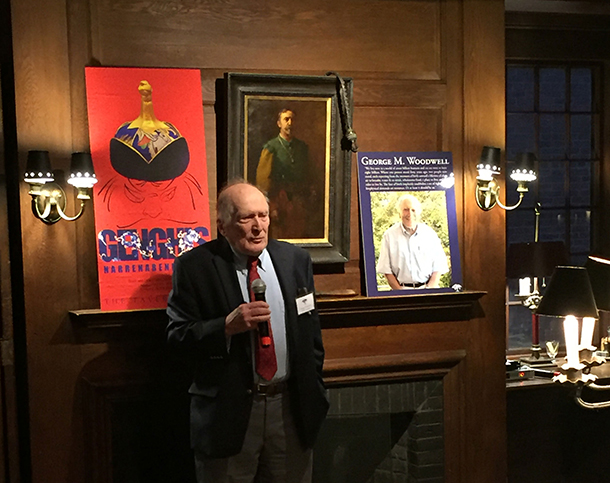
Woodwell speaking at the Tavern Club in Boston at an event honoring the release of his book. (Photo: Steve Curwood)
WOODWELL: Well, I think the Paris climate agreement is a political and economic compromise. I think the scientific community should not have accepted that and should be up in arms at the moment, saying, “It cannot work. It will not work. It cannot work, and it cannot be allowed.” The only course at the moment is to make the transition from fossil fuels to renewable energy sources, a perfectly attractive and possible and financially attractive, lucrative transition. It's not a dream, but it is a dream world. It’s a world that everyone would like to live in, and it's a clean world in which human rights are protected, the common property resources of air, water, and land are cherished and defended, and industries have a purpose, a primary purpose, which is the quality of the public realm.
CURWOOD: George Woodwell, of all the things you've worked on over the past years, what do you feel was the most important? Where do you feel you really made the biggest difference?
WOODWELL: Well, I'm not sure I've made any difference, but I've been very fortunate to work on a series of topics which have turned out to be great issues of environment. So, to the extent that the public realizes that they are great issues and that correcting them, turning them to human advantage requires fundamental changes in how we manage the world, and the responsibility for that is a core purpose of Government. Governments forget. In their enthusiasm for developing economic goods they forget that they have a fundamental responsibility to protect ecological integrity, and to the extent that the public realizes that I think we've made a contribution. I'm not sure that the intensity with which the public can realize that is going to be great enough to correct the trends at the moment, which any ecologist sees as thoroughly threatening.
CURWOOD: George Woodwell’s new book is called “A World To Live In.” He’s the Director Emeritus of the Woods Hole Research Center. Thank you so much for taking the time with us today, Dr. Woodwell.
WOODWELL: Well, I'm delighted, always delighted to talk about these matters.
Related links:
- About George M. Woodwell
- The 2001 Volvo Environmental Prize citation for George M. Woodwell
- The Heinz Award citation for George M. Woodwell
- A World To Live In
[MUSIC: Liz Carroll/John Doyle, “A Long Night On the Misty Moor,” In Play, Compass Records]
The Place Where You Live: Bear Creek, WI and St. Paul, MN
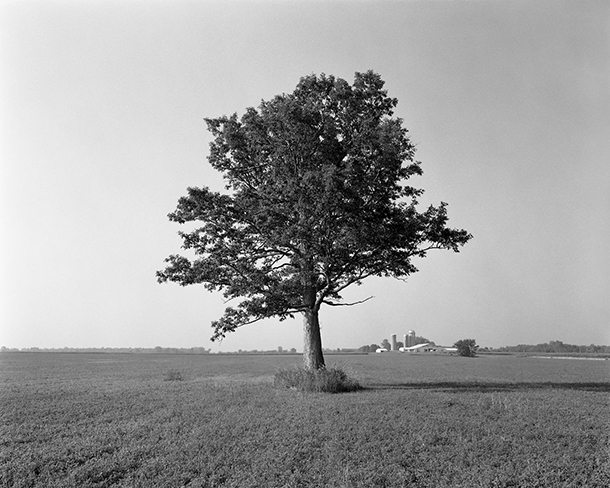
Regina Flanagan took the photo of the Lunch Tree that inspired her essay in August 2005, at her family’s dairy farm in Bear Creek, Wisconsin. (Photo: Regina Flanagan)
CURWOOD: We take a trip now to St Paul Minnesota and Bear Creek Wisconsin, for another installment in the occasional Living on Earth/Orion Magazine series “The Place Where You Live.” Orion invites readers to put their homes on the map and submit essays to the magazine’s website, and we give them a voice.
[MUSIC: Edward Sharpe and The Magnetic Zeroes “Home” from Edward Sharpe and The Magnetic Zeroes (Rough Trade Records 2009)]
CURWOOD: A single white oak in a field near a childhood home is the inspiration for today’s essay.
FLANAGAN: I’m Regina Flanagan, and this is my essay entitled, “Lunch Tree.”
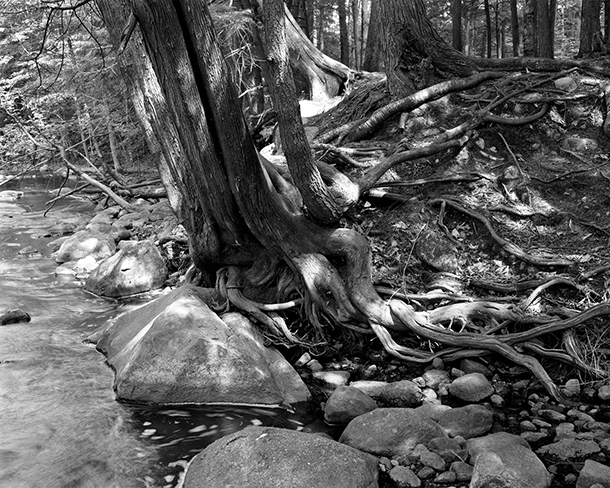
Nature is a frequent subject of Regina’s photography. She took this photo of a riverbed and tree roots at the Embarrass River in Haymans Falls County Park, Wisconsin. (Photo: Regina Flanagan)
I learned much later, after my brothers had taken over the dairy farm, that my dad called the solitary white oak in the middle of the field near the creek “The Lunch Tree.”
[MUSIC: “Unfamiliar Wind,” Brian Eno, Ambient 4, EG Records 1982]
Before I became a teenager and felt confined by the isolation of the farm [COWS LOWING] and thought that somehow it was keeping me from participating in the wide world outside, this landscape was my world, as it was for my dad. While I played in the hedgerows between the fields, discovering remnant patches of wildflowers, and ventured down the lane next to the woods until that exciting moment when our house was out of sight. My dad was sowing crops for the cows, corn or alfalfa hay in the broad fields.
Long before my dad farmed the land, someone had chosen to retain that solitary oak tree. [INSECTS BUZZING] It became the place where, at high noon in its shade, Dad would take a break from work, and we would eat our sandwiches and sip water from a red and white insulated cooler jug.
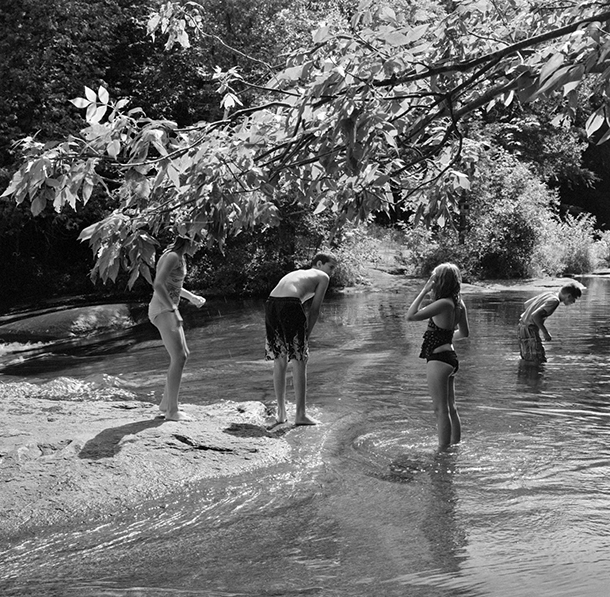
Kids explore the Red River near Gresham, Wisconsin in this August 2013 photo by Regina. (Photo: Regina Flanagan)
Now I live in a city where I find stimulation, and where I work as an artist in a neighborhood that is leafy and green and more wooded than the place where I grew up. When my siblings, nieces, and nephews from the farm visit, they are amazed by all the trees. Such diversity! Lining my street are maples, swamp white oaks, river birches, hackberries, and even a few elms. Neighbors up and down our block chip in to inoculate them against Dutch elm disease every few years, to retain their majestic canopy.
The trees along my street are here because humans decided to plant and care for them. The Lunch Tree was retained by a settler, clearing land for farming over one hundred years ago. They are all chosen trees. They endure because of human choice and care.
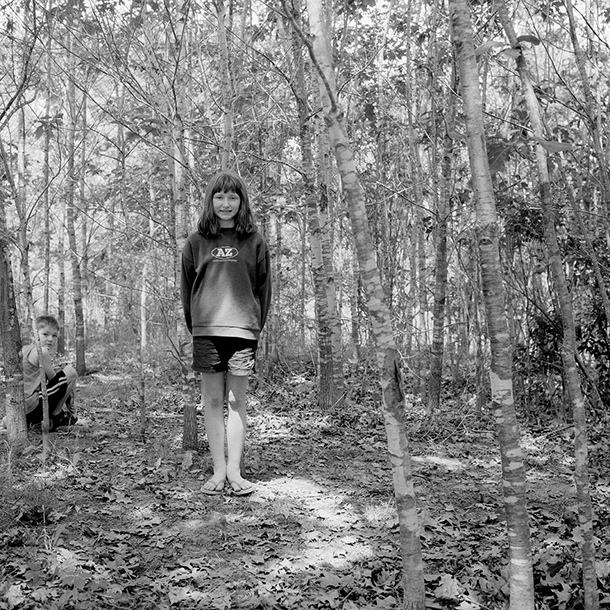
A 2006 photo by Regina, taken in a red oak grove near Bear Creek, Wisconsin, echoes the exploring she used to do there as a young girl growing up in the 1950s and 60s. (Photo: Regina Flanagan)
[MUSIC: “A Clearing,” Brian Eno, Ambient 4, EG Records 1982]
So, the next time you notice a solitary tree in the countryside, in an open field or along the road, you’re seeing not only a survivor of the original landscape, but the expression of a choice made long ago by people like my dad, who felt a deep affection for that place.
[MUSIC AND FARM ANIMAL SOUNDS]
The farm remains a working farm in my family to this day, outside the village of Bear Creek, which is west and south of Green Bay. I’m a landscape architect and photographer, and I presently live in St. Paul, Minnesota. My essay is about one of my photographs, an image of a white oak, standing alone in a field of shorn alfalfa on a clear, cloudless morning. My brothers’ barns and silos are visible in the distance.
My photography is kind of the thread that connects all the pieces of my life. There are stories that a photograph can tell, but there’s also things that are not visible in the photograph and that are really about its history. The oak tree is actually a remnant of a landscape that only exists in small pieces still on the farm. That includes a small woodlot that was never logged, also a small creek where I played as a child.
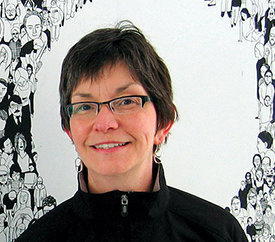
Regina Flanagan is a photographer and landscape architect who lives in St. Paul, Minnesota. (Photo: courtesy of Regina Flanagan)
In the late 1950s and early 1960s we were sent outdoors to play, and we were often out all day. Sometimes my mom would pack me a hobo lunch, and I’d take off to have an adventure.
[INSECTS BUZZING, MUSIC, WATER SOUNDS]
My favorite destination was the creek down the lane, which is a cow path, really, that connected the farm fields. It was bounded by the woods on one side and on the other side by a barbed wire fence and then the fields where the cows were pastured. The woods were magical. I’d pore over the plants on the ground and the details of the leaves, their forms and shapes and occasional flowers, and I’d often wonder about the plants. What were their names and how they got there. They were the landmarks, especially the oak trees.
The sensations are still very vivid -- The changes of light and shadow, the tangy smell of decaying plants in the wet meadow, and especially the trill of redwing blackbirds.
[RED-WINGED BLACKBIRD SONG]
[MUSIC: “Home,” (orig. performed by Philip Philipps) [Piano Karaoke Version], arr. Sing2Piano 2012]
CURWOOD: That’s Regina Flanagan, and the Lunch Tree. There are pictures at our website, loe dot org – and there you’ll also find details about Orion Magazine and how to submit your essay, if you want to tell us about the place where you live.
Related links:
- See more of Regina Flanagan’s photography
- Find more The Place Where You Live essays featured on Orion Magazine’s website
Living on Earth is holding a special symposium on our oceans and our future, and you are invited. Join me, Blue Planet champion Carl Safina, and UMass Boston ocean law and management expert John Duff, Friday afternoon on August 12th on Nantucket Island. Details are on our website at loe.org, or call 617-287-4122 for more information.
Living on Earth is produced by the World Media Foundation. Our crew includes Naomi Arenberg, Bobby Bascomb, Jenni Doering, Anica Green, Jay Feinstein, Emmett Fitzgerald, Jaime Kaiser, Don Lyman, Helen Palmer, Charlotte Rutty, Adelaide Chen, Jennifer Marquis and Jolanda Omari. Tom Tiger engineered our show, with help from Zack Ronald, Jake Rego and Noel Flatt. Alison Lirish Dean composed our themes.
Find us anytime at L-O-E dot org - and like us, please, on Facebook - It’s PRI’s Living on Earth. And we tweet from @livingonearth. I'm Steve Curwood. Thanks for listening.
ANNOUNCER1: Funding for Living on Earth comes you, our listeners, and from the University of Massachusetts, Boston, in association with its School for the Environment, developing the next generation of environmental leaders. And from the Grantham Foundation for the protection of the environment, supporting strategic communications and collaboration in solving the world’s most pressing environmental problems. Support also comes fom the Energy Foundation, serving the public interest by helping to build a strong, clean, energy economy, from Gilman Ordway, and from SolarCity, America’s solar power provider. SolarCity is dedicated to revolutionizing the way energy is delivered by giving customers a renewable alternative to fossil fuels. Information at 888-997-1703. That’s 888-997-1703.
ANNOUNCER2: PRI. Public Radio International.
Living on Earth wants to hear from you!
Living on Earth
62 Calef Highway, Suite 212
Lee, NH 03861
Telephone: 617-287-4121
E-mail: comments@loe.org
Newsletter [Click here]
Donate to Living on Earth!
Living on Earth is an independent media program and relies entirely on contributions from listeners and institutions supporting public service. Please donate now to preserve an independent environmental voice.
NewsletterLiving on Earth offers a weekly delivery of the show's rundown to your mailbox. Sign up for our newsletter today!
 Sailors For The Sea: Be the change you want to sea.
Sailors For The Sea: Be the change you want to sea.
 The Grantham Foundation for the Protection of the Environment: Committed to protecting and improving the health of the global environment.
The Grantham Foundation for the Protection of the Environment: Committed to protecting and improving the health of the global environment.
 Contribute to Living on Earth and receive, as our gift to you, an archival print of one of Mark Seth Lender's extraordinary wildlife photographs. Follow the link to see Mark's current collection of photographs.
Contribute to Living on Earth and receive, as our gift to you, an archival print of one of Mark Seth Lender's extraordinary wildlife photographs. Follow the link to see Mark's current collection of photographs.
 Buy a signed copy of Mark Seth Lender's book Smeagull the Seagull & support Living on Earth
Buy a signed copy of Mark Seth Lender's book Smeagull the Seagull & support Living on Earth

